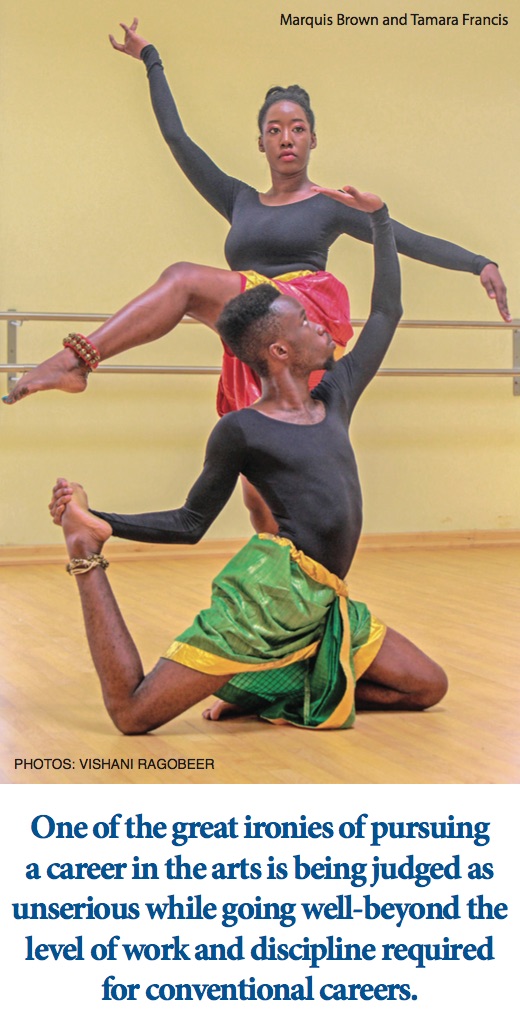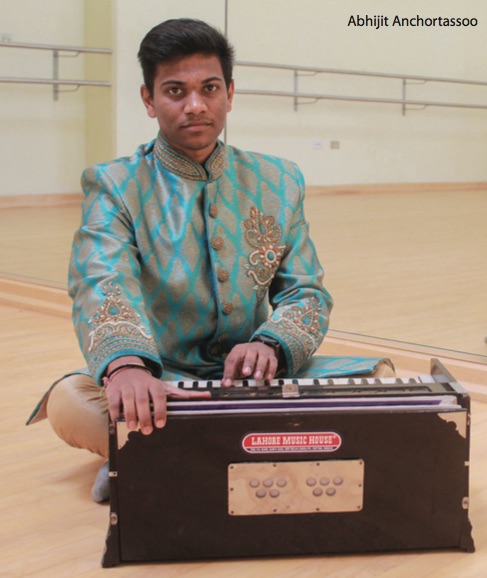DCFA students learn the arts of India
Abhijit’s voice rises over the harmonium, filling the studio. Abhijit Anchortassoo, age 22 - a few minutes before he’d been a soft-spoken young man, now he’s a powerful vocalist. His song is Indian classical music.

Winner of the NCIC Divali Nagar Youth Champ competition for both 2018 and 2019, multiple instrument- playing arranger and performer, and even a music teacher, Abhijit does all this and is pursuing his Bachelor of Arts (BA) in Musical Arts at UWI St Augustine’s Department of Creative and Festival Arts (DCFA).
“I did my research and saw that UWI is the best in the Caribbean,” he says when explaining his reason for choosing to come to the DCFA. “So I wanted to ground my experience here. And from what I’ve experienced it is the best. It’s been an amazing experience.”
Abhijit is one of many students in the DCFA’s Musical Arts and Dance programmes that have committed to the artistic and cultural forms of India and Indo-Trinidad. The department’s programmes are well-rounded, giving students the fundamentals of their art form and a deep education in several styles. Music students learn performance, theory, jazz, music history, steelpan and Indian Classical. Dance students learn Caribbean dance, ballet technique, modern dance, dance history and Indian dance.
Marquis Brown, age 21, a final year Dance student, says, “With Indian dance every single part of your body tells a story.”
It is one of the reasons he was captivated by the art form. A young man of African descent, Marquis is an outstanding student, says Ms Deboleena Paul, DCFA’s Lecturer in Indian Dance. Both Marquis and fellow student 22-year-old Tamara Francis, another exceptional dancer, were influenced by the work of Ms Paul.
“When I saw Ms Deboleena’s choreography I knew to myself I wanted to see how much I could learn in Indian dance,” says Tamara, who is from Mayaro.
The BA in Dance includes Indian Dance 1 and 2. In these courses students learn the language of Indian dance (Sanskrit) and about the eight classical styles and the many folk/festival styles. They are trained in three classical styles - Kathak, Bharatanatyam and Manipuri, and also learn some folk.
Although Abhijit learned the history of Indian classical music and about the genres of the art form, he already had a strong grounding through his family:
“My family is very musically oriented. It stems all the way back to my great granddad from when he came from India. He had deep roots in music. Our family has a passion for music that goes down the generations. My dad instilled that in me.”

Abhijit plays the violin, mandolin, keyboard, dholak, tabla, harmonium, tassa and a bit of steelpan. He recently started bass guitar. He is a Vocal major at DCFA. He first began playing music at age 8 and won the Children of Mastana Bahar competition all the way back in 2011. Still, he says the Music degree has been vital for his development. In particular, he points to his education in Western classical music.
“I’m grateful to DCFA for giving me the edge with Western classical music,” he says. “I have been taught to read and understand sheet music. I can sit down, read music and play with any musician. This gives me the ability to work better with foreign musicians.”
He is also extremely grateful for the teaching of master Indian classical violinist, composer, arranger and educator Shivanand Maharaj, the Indian Classical Music instructor at DCFA.
“He is a role model for me,” says Abhijit. “He’s always a motivator. He always encourages me. He tries his best to provide opportunities for all his students.”
(Mr Maharaj was in India for a performance at the Taj Mahal at the time of this writing).
The quality of the DCFA’s lecturers and instructors is extremely high. Dance lecturer Deboleena Paul has three master’s degrees in dance in her home country of India. She first came to Trinidad as a cultural ambassador of the Indian High Commission, representing the art form on behalf of India throughout the Caribbean as a dance teacher, performer and choreographer.
“As soon as I came off the plane in Piarco I said, ‘this is like India’,” she recalls. “I thought to myself, ‘I like this country. How can I stay?’”
Paul is surprisingly warm and easygoing for someone who has essentially dedicated her life to dance. Starting from age 3 in her home of Badarpur in northeast India. She has learned dance in schools, in private study as a disciple to various masters and at university. She has received national awards from the Government of India, including the Buddha Ratna Award in 2007.
Nevertheless, as easygoing as she seems, when it comes to teaching, she is very serious. Her students usually expect a two-hour class to extend to three hours.
“Especially when we are dealing with miss, because she wants perfection,” says Tamara.
As challenging as it is, however, they embrace it. Marquis says, “The Time and energy that miss puts into us, we have to give her back that same thing. We have to give her back that same love and appreciation for the art itself.”
One of the great ironies of pursuing a career in the arts is being judged as unserious while going well-beyond the level of work and discipline required for conventional careers. Tamara and Marquis have to spend several hours a day, several days a week involved in rigorous physical activity to improve Abhijit has to balance classes, assignments, practise and a career as a musician. They are all almost supernaturally focused with a maturity and commitment well beyond their years.
“There is always the challenge where you will find people that say ‘why are you doing a music degree?’” says Abhijit. “I smile and I don’t bother to tell them anything. I let my actions speak for themselves.”
For anyone considering turning their passion for the arts into a career, he adds, ““I work extremely hard and I encourage people, especially if they have a passion for art, pursue it. You have one life to live and you should spend it doing the thing you love most.”